英语翻译技巧之反译法(negation)
翻译常用的八种技巧
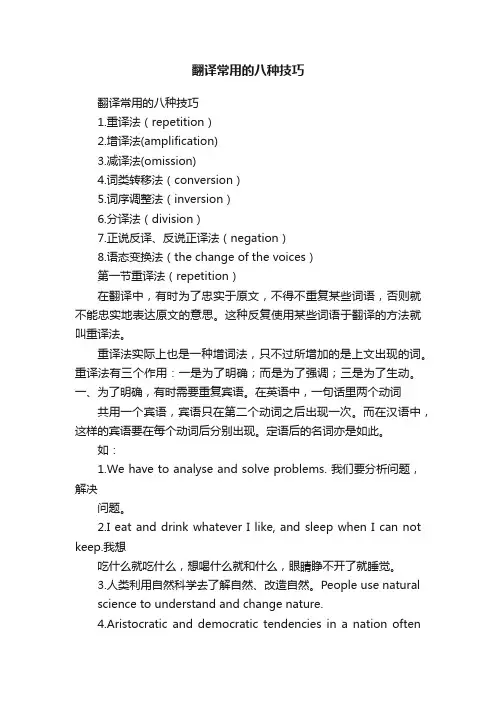
翻译常用的八种技巧翻译常用的八种技巧1.重译法(repetition)2.增译法(amplification)3.减译法(omission)4.词类转移法(conversion)5.词序调整法(inversion)6.分译法(division)7.正说反译、反说正译法(negation)8.语态变换法(the change of the voices)第一节重译法(repetition)在翻译中,有时为了忠实于原文,不得不重复某些词语,否则就不能忠实地表达原文的意思。
这种反复使用某些词语于翻译的方法就叫重译法。
重译法实际上也是一种增词法,只不过所增加的是上文出现的词。
重译法有三个作用:一是为了明确;而是为了强调;三是为了生动。
一、为了明确,有时需要重复宾语。
在英语中,一句话里两个动词共用一个宾语,宾语只在第二个动词之后出现一次。
而在汉语中,这样的宾语要在每个动词后分别出现。
定语后的名词亦是如此。
如:1.We have to analyse and solve problems. 我们要分析问题,解决问题。
2.I eat and drink whatever I like, and sleep when I can not keep.我想吃什么就吃什么,想喝什么就和什么,眼睛睁不开了就睡觉。
3.人类利用自然科学去了解自然、改造自然。
People use naturalscience to understand and change nature.4.Aristocratic and democratic tendencies in a nation oftenshowthemselves in its speech.民族的贵族倾向和民族倾向常在其言语中表现出来。
5.我们来修改安全规则和卫生规则吧。
Let’s revise our safety andsanitary regulations.二、英语常用省略,但为了明确,也为了强调某些内容,在汉语中常常要将省去的部分重译出来。
翻译技巧 之正说反译与反说正译

e.g. 800 people had been saved by the organization.
组织拯救了800人.
3、翻译成汉语判断句:不突出被动动 作,而着重于对事 物的状态、过程和性 质等加以描述,经常采用“是……的” 判断句。
e.g. This kind of device is much needed in the mechanical watch-making industry.
我一时想不起来这个名字。
2.Negative in English, Affirmative in Chinese 反说正译
e.g. My overcoat would not wear out.
我的大衣十分耐穿。
3.Double Negative for Emphasis 双重否定为强调
e.g. He was no small reputation as a scientist.
这种装置在机械表制造业中是很重要的。
4、把被动句中的“被”字用其它字替 代:“被”— “受、遭、让、由、得以、 受到、遭到、为……所”等。
e.g. The proposal on the improvement of the investment environment is accepted by all the members of the committee.
这条关于改善投资环境的建议为该委员会 全体委员所接受。
5、被动惯用句型:泛指我们、人们、 有人、大家等。
有人认为...
e.g. It is believed that almost all sudden deaths are caused by damage to the heart.
6 正说反译、反说正译法
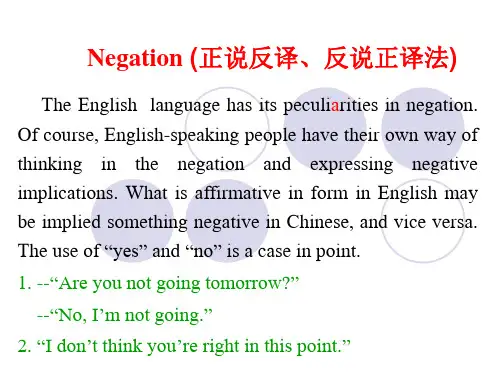
天渐渐有些亮了,但他们还在睡。 但他们还在睡。
1. I have failed to convince him of his error. 2. The teacher found some of the students absent. 3. His answer is beside the mark. 4. They never see each other without talking about Super Girl's Voice. 5. The County Party Committee there is ignorant of conditions at the lower lever. 6. That fellow is far from being honest. 7. She refrained from laughing. 8. All graduates from the Foreign Languages Institutes will not be appointed to do translation work. [Version]
D: The Shift of Perspective (视角转换) (视角转换 视角转换) 7 .Good winner, good loser. 胜不骄,败不馁。 8. 在美国,人人都能买到枪。 原译:In the United States, everyone can buy a gun. 改译:In the United States, guns are available to everyone. 9. The darkness was thinning, but they were still in bed.
Discussion: “你是人,你不是东西。你是东西吗?你真 不是东西!?我认为你不是东西。你算什么东西!” Version: You’re a person, not a thing. Aren’t you a person/a thing? Are you reliable/ some-thing? No, I don’t think so./Yes, I think so. What a creature you are! What a fool you are! You are a sheer idiot. I think you are an idiot. I don’t think you are trustworthy. You, really, are nothing. You think you are something. No, far from it. Purposes of Affirmation and Negation 1. to make the meaning clear, 2. to strengthen the rhetorical effect, 3. make it conform to the idiomatic use of the target language
翻译的八大常用技巧
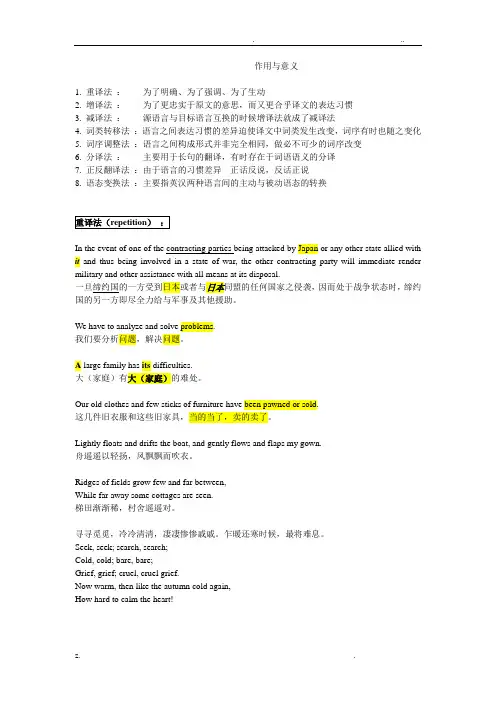
作用与意义1. 重译法:为了明确、为了强调、为了生动2. 增译法:为了更忠实于原文的意思,而又更合乎译文的表达习惯3. 减译法:源语言与目标语言互换的时候增译法就成了减译法4. 词类转移法:语言之间表达习惯的差异迫使译文中词类发生改变,词序有时也随之变化5. 词序调整法:语言之间构成形式并非完全相同,做必不可少的词序改变6. 分译法:主要用于长句的翻译,有时存在于词语语义的分译7. 正反翻译法:由于语言的习惯差异---正话反说,反话正说8. 语态变换法:主要指英汉两种语言间的主动与被动语态的转换In the event of one of the contracting parties being attacked by Japan or any other state allied with it and thus being involved in a state of war, the other contracting party will immediate render military and other assistance with all means at its disposal.一旦缔约国的一方受到日本或者与日本同盟的任何国家之侵袭,因而处于战争状态时,缔约国的另一方即尽全力给与军事及其他援助。
We have to analyze and solve problems.我们要分析问题,解决问题。
A large family has its difficulties.大(家庭)有大(家庭)的难处。
Our old clothes and few sticks of furniture have been pawned or sold.这几件旧衣服和这些旧家具,当的当了,卖的卖了。
Lightly floats and drifts the boat, and gently flows and flaps my gown.舟遥遥以轻扬,风飘飘而吹衣。
英译汉翻译技巧
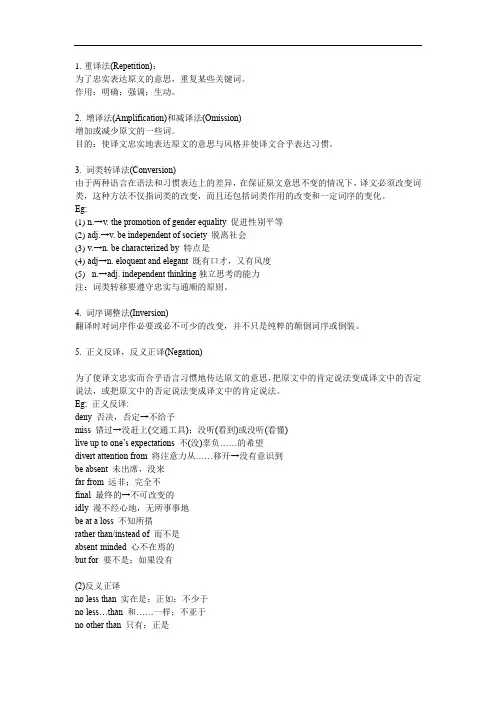
1.重译法(Repetition):为了忠实表达原文的意思,重复某些关键词。
作用:明确;强调;生动。
2. 增译法(Amplification)和减译法(Omission)增加或减少原文的一些词。
目的:使译文忠实地表达原文的意思与风格并使译文合乎表达习惯。
3. 词类转译法(Conversion)由于两种语言在语法和习惯表达上的差异,在保证原文意思不变的情况下,译文必须改变词类,这种方法不仅指词类的改变,而且还包括词类作用的改变和一定词序的变化。
Eg:(1)n.→v. the promotion of gender equality 促进性别平等(2)adj.→v. be independent of society 脱离社会(3)v.→n. be characterized by 特点是(4)adj→n. eloquent and elegant 既有口才,又有风度(5)n.→adj. independent thinking独立思考的能力注:词类转移要遵守忠实与通顺的原则。
4. 词序调整法(Inversion)翻译时对词序作必要或必不可少的改变,并不只是纯粹的颠倒词序或倒装。
5. 正义反译,反义正译(Negation)为了使译文忠实而合乎语言习惯地传达原文的意思,把原文中的肯定说法变成译文中的否定说法,或把原文中的否定说法变成译文中的肯定说法。
Eg: 正义反译:deny 否决,否定→不给予miss 错过→没赶上(交通工具);没听(看到)或没听(看懂)live up to one’s expectations 不(没)辜负……的希望divert attention from 将注意力从……移开→没有意识到be absent 未出席,没来far from 远非;完全不final 最终的→不可改变的idly 漫不经心地,无所事事地be at a loss 不知所措rather than/instead of 而不是absent-minded 心不在焉的but for 要不是;如果没有(2)反义正译no less than 实在是;正如;不少于no less…than 和……一样;不亚于no other than 只有;正是none other than (用以加强语气) 正是,恰恰是,不是别人,正是……nothing but 只有(是);只不过no choice but 别无选择,只(好)得unfold 展开,呈现disappear 消失,失踪carelessly 马马虎虎地,粗心地6. 分译法(Division)分译法主要用于长句的翻译。
与翻译有关的那些--反译法
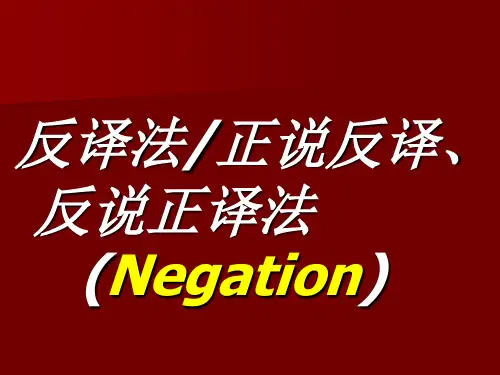
The window refuses to open. 窗户打不开。
正说反译法(动词)
She was refused admittance by them. 他们不许她进去。 Permission to enter was denied. 不准入内。 I was denied the chance of going to university. 我没有得到上大学的机会。
Her abstraction was not because of the tea party. • 她那心不在焉的神情,并不是因为茶话会。
His hesitation led to his failure. • 他不果断/犹豫不决导致了他的失败。
正说反译法(虚词:介词)
To do this is beyond my ability. 干这事我力不胜任。 It was beyond his power to do so. 他无权这样做。
正说反译法(虚词:连词)
The soldiers would fight to death before they surrender. 战士们宁可战斗到死,而决不投降。
I will not go unless I hear from him. 如果他不通知我,我就不去。
正说反译法(虚词:连词)
What you’ve said is above me. 你所说的我不懂。
正说反译法(虚词:介词)
It seems against nature. 这似乎不符合自然规律。
He is above meanness and deceit. 他不至于做卑鄙和欺骗人的事情。
正说反译-反说正译
1. Unless something is moved,no work is done. 译文:除非某种东西被移动,否则功不会被完 被 被 成。 2. Only objects struck by the light are visible. 译文:只有被光明照到的东西才能被看见。 被 被 上两句一定要用“被”字吗? 改译:1. 除非某种物体发生了 发生了移动,否则就没 发生了 没 有功。 2. 光照射到的物体是可见的 是可见的。 是可见的
(1) After you, sir. 先生,您先请。 (2) The worst of the problem is behind us. 这问题最坏的情况已经过去了。 3)The darkness was thinning, but the street was still dimly lighted. 天渐渐有些亮了,然而街上还亮着暗淡的灯光。 4)…… he drove slowly down the hill, his elbows resting on the wheel, his chin cupped in his hands. 他慢慢顺山坡向下开去,两肘支在方向盘上,双 手拖着下巴。
参考译文
(1)他说他对她感激不尽,简直难以表达他的 谢意。 (2)他理应受到表扬,怎么表扬也不过分。 (3)遇到这种不幸事件愈少见邻居愈好。 (4)但愿我们搬得愈远愈好;我现在讨厌这该 死的小镇和这里所有的人。 (5)战争并不因我知道它终究会来就为了迎合 我而来得很快。
(1) All’s not smooth for Lakers. (标题) 湖人队未必一帆风顺。 (2) All that glitters is not gold. 发光的不一定就是金子。 (3) All is not right. 未必全对。 (4) Jordan replied, “Every year is not going to be a great year.” 乔丹回答说:“并不是每年都是顺利的”
英汉互译八种技巧
❖ 6.重复副词 ❖ Nels had it all written out neatly. ❖ 纳尔斯把它写得清清楚楚。 ❖ By and by the building rose up. ❖ 楼房一点一点地升起来了。 7,使用四字词组 Come over and have a rest. 过来休息休息。
❖ 先生们尽管可以高呼和平,和平!但是依然没有和 平。
❖ We must enrich our cultural and material lives.
我们必须丰富我们的精神生活和物质生活。 (宾语前有多个定语时,要重复这个做宾语 的名词)
2)重复做表语的名词
This is a victorious conference that shows our unity.
8. 留得青山在, 不怕没柴烧。 So long as green hills remain, there will never be a shortage of firewood.
3. 减译法
❖ 增译法的反面
❖ 减译法是指原文中有些词在译文中不译出来, 因为译文中虽无其词而已有其意,或者在译文 中是不言而喻的;
❖ I am looking forward to the holidays. ❖ 我们等待假日的到来。
❖ Much of our morality is customary. ❖ 我们大部分的道德观念都有习惯性。
❖ Reading makes a full man; conference a ready man; and writing an exact man.
1. 重复法
1. 汉语重复,英译时也重复;
翻译技巧删减和否定翻译法
• 无”、“几乎没有”、“几乎不”等简单的 词汇。
III. Negation in translation
1 .全部否定
• 在英语中,全部否定是通过一些否定词来表达的。 这类否定词常用的有:no, none, not, never, nobody, nothing, nowhere, neither…….. nor 等。全部否定的译法一般可直接译成汉语的否定 句。例如:
6. 英语中反诘问句
• 1) Don’t you think it foolish to act like this?
• 难道你不认为这样做很傻吗? 2) Hasn’t the train arrived? 火车难道还没到?
III. Negation in translation
7.否定转移
• 形式上否定的是谓语动词, 而实际意义上 否定的是另一个名词短语
•
答英语卷越仔细越好。
• 2) This point cannot be overemphasized.
• 这一点应该特别强调。(或:这一点怎么 强调也不过分。)
III. Negation in translation
4. 形式上否定,意义上肯定
• “no, none, nothing + but, like”意为“只 有”、“只”、“不过”等。“nothing short of ”则有“简直可以说”的意思。如:
• 然而,那位小说家的侦探案例并不都是那么成功的。 • 2) Both the instruments are not precision ones. • 这两台仪器并非都是精密的。 • 3) The bell had hardly rung when the teacher came
翻译笔记之八大技巧
Eight translation techniques1.增译法(amplification);2.重译法(repetition);3.减译法(omission);4.词类转移法(conversion);5.词序调整法(inversion):6.分译法(division);7.正说反译,反说正译(negation);8.语态变换法(the change of the voices)Group competition1.I am looking forward to the holidays.我在等待假日的到来.2.Much of our morality is customary.我们大部分的道德观念都有习惯性。
3.Courage in excess becomes foolhardiness,affection weakness,thrift avarice.勇敢过度,即成蛮勇;感情过度,即成溺爱;俭约过度,即成贪婪。
4. Histories make men wise;poets witty;the mathematics subtle;natural philosophy deep;moral grave;logic and rhetoric able to contend.读史使人明智,读诗使人灵秀,数学使人周密,科学使人深刻,伦理使人庄重,逻辑修辞使人善辩。
5. As an Oriental,I cannot but be proud of your historic achievement.作为一个东方人,我不得不为贵国所取得的历史性成就感到骄傲。
Amplification 增译法Three types: Semantic amplification,Grammatical amplification,Rhetoric amplificationSemantic amplification1. The crowds melted away人群渐渐散开了.2. We were all greatly moved by his loftiness.我们都被他那种崇高品质所深深感染.3. He felt the patriot rise within his breast.他感到一种爱国热情在胸中激荡.loftiness patriot: 英语习惯运用抽象词汇,而汉语习惯运用具体词汇将“抽象概念变为具体概念”,类似词汇如:arrogance, indifference, tension,confusion, solution, remedies, jealousy, fault-finding增补概括性的词1. The advantages of the meeting room are bright, spacious, fashionable, and without echoes.这个会议室有四大优点:明亮、宽敞、时髦、无回声。
- 1、下载文档前请自行甄别文档内容的完整性,平台不提供额外的编辑、内容补充、找答案等附加服务。
- 2、"仅部分预览"的文档,不可在线预览部分如存在完整性等问题,可反馈申请退款(可完整预览的文档不适用该条件!)。
- 3、如文档侵犯您的权益,请联系客服反馈,我们会尽快为您处理(人工客服工作时间:9:00-18:30)。
• Not… and … VS Not… or…
E.g. He did not speak clearly and correctly. He did not speak clearly or correctly.
他讲得清楚,但不正确。
他讲得不清楚,也不正确。
(2). Full negation (全部否定)
big audience. • 昨天总统在大庭广众面前即席致辞。 • Aren’t they fine, these three men are going off into nowhere
like that? • 这三人真行,前途茫茫,就这样去了。
(2). Conversion of Negative Sentences into Affirmatives • My overcoat would not wear out. • 我的大衣十分耐穿。 • If that isn’t what I want! • 我所要的就是这个呀! • Nothing is more deceitful than the appearance of humility. • 谦卑的外表是最易使人上当的。
翻译技巧之反译法 Negation
1. Transfer of the Negative (否定转移)
(1). 把主句的否定转移到that从句
• think, believe, suppose, expect, imagine, fancy, reckon 引导的从 句,在英翻中时应使用否定转移 E.g. We don’t believe that our mother tongue is inferior to any other
Negative (肯定形式译成否英语句子中既没有否定词,如no, not, never, none, neither, nobody, nothing, nowhere , nowise, 也没有带有否 定前缀或后缀的词,如dis-, im-, in-, ir-, non-, un-, -less.
Words
incomplete unasked
unprecedented dislike disbelief
Negative Form
不完全的 未经邀请的 前所未有的
不喜欢 不相信
Affirmative Form
残缺的 自告奋勇的
空前的 反感、讨厌
怀疑
undisguised
无伪装的
公然、公开的
E.G. • Yesterday the President gave an unprepared speech before a
(2). Translation of Negative Questions
• Look, some buses are coming this way, don’t you see them? • 瞧,有几辆公共汽车往这边开来了,你看见了吗?(cf.
你没看见吗?)
• Some questions in English look like disjunctive questions, but actually they are not. The statement and question have two different subjects covering different persons or things. In translation, the negation is generally not expressed.
• Not + full negative : Partial negative
E.g. Not many people have nowhere to live. ≈ Most people have somewhere to live.
不是很多人没有地方住。
• Not…for nothing: Partial negative E.g. All these investigations are not done for nothing. 这些调查并不是白做的。
• Full negative + affirmative predicate: E.g. Nobody succeeds.
• Full negative + words with negative prefixes or suffixes, or words implying negation. E.g. He was always unkind.
中文的肯定句又是怎样的呢? --中文的肯定句,句子中不含有“不”,“非”,“否”, “没(有)”,“未”,“别”,“勿”,“莫”, “休”,“甭”。
E.g. • Take it or leave it. • 买不买随你。
• That time when we caught Molly I doubled up with laughter. • 我们抓住莫莉那一回,我笑得直不起腰来。
language in the world. 我们相信,祖国的语言并不亚于世界任何其他语言。
• 有些动词,如assume, surmise 和presume,引导的从句中,在英 翻中时主句的否定不能转移到从句当中 E.g. I can’t assume that he came. 我不能假定他来了。
• I wonder if he cannot help me out of the difficulty. • 我不知道他是否能帮我摆脱这个困境。 • I am writing to ask your help in seeing if the provisions of the
agreement cannot be implemented in the next few weeks. • 兹函请惠予注意协议条款是否可在今后几周内实施。
• Literary style:岂不 • Modern or colloquial style:难道
• Is this the part of wise men, engaged in a great and arduous struggle for liberty? Are we disposed to be of the number of those, who having eyes, see not, and having ears, hear not, the things which so nearly concern their temporal salvation?
4. Translation of English Questions
and Answers (英语问答句译法)
( 1). Translation of Answers to Negative Questions
• 注意:在回答否定问句时,英汉间的差异。 • Are you not prepared to do this work? • 你不打算做这项工作吗? • Yes, I am. • 不,我打算做。 • No, I’m not. • 是的,我不打算做。
• I like Xiamen very much, don’t you? • 我很喜欢厦门,你呢?
• He won’t go home, but will she? • 他不回家,那她呢?
(3). Translation of Answers to Disjunctive Questions
• It’s not going to rain, is it? • 不会下雨,是不是? • No. • 是的,不会。 • Yes. it’s going to rain. • 不,会下雨的。
• Full affirmative + not / not + full affirmative: Partial negative
E.g. A man of learning is not always a man of wisdom. 有学问的人不一定是有智慧的人。
Attention!!
• “all the + noun + not” and “ not all the + noun ”: full negation E.g. All the money in the world won’t make you happy. 即使你拥有了世界上所有的财富,你也不会快乐。
satisfied. 你不可只因为她不抱怨,就以为她心满意足了。
(3). 把句子的其他成分转移到动词
E.g. He gave me not even a moment to collect my thoughts. 他甚至不给我片刻时间去集中思考。
2. Conversion of the Affirmative in to the
Silent Answers
• “You’re not going to school today?” Mother shouted down the stairs to her little one. The child looked up and shook his head.
• “今天你就不上学啦?”母亲从楼上喊下来,问她的小宝 贝。孩子抬起头来点了一下。
• 为争取自由而从事伟大而艰巨的斗争的明智人士,难道应 该这样做吗?对于目前自救运动密切相关的事业视而不见、 充耳不闻的人,难道我们甘心情愿与之为伍吗?
(5). Translation of Indirect Negative Questions
• Negation can be found even in indirect questions, which in our mode of expression should be in a tone of uncertainty, such as “是否可以……”, “能不能……”. A literal translation will confuse the reader.
